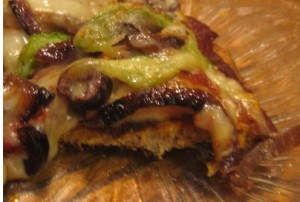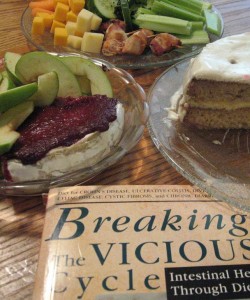Without realizing it, my husband and I raced against each other last night to have separate pizzas ready for dinner. It was Friday afternoon after a long week for me, I had the afternoon off work. At 4:00, he asked “Can I just go to the grocery store and buy a frozen pizza for dinner?” Of course we’re talking gluten-packed, highly processed pizza here. No problem I said. I can always eat eggs; kind of my SCD hunger mantra, if nothing else, I can have eggs.
I can’t force others to eat healthy. My husband doesn’t eat SCD, nor do the kids, but he tries to help me as much as he can. I’ve been reading a blog called Paleo non Paleo and am heartened to read that someone else has the courage to write about living with a spouse who’s not on the same restrictive diet path. Of course, her husband jumped on board after 14 months, but she still writes Paleo non Paleo. Don’t get me wrong, I am grateful for my husband’s support; he cooks dinners most nights, and he does his best to provide me with SCD meals, which I appreciate, it’s just that some days are easier than others to resist non-SCD treats. And as I’ve said, I don’t experience severe consequences for straying, so my penalty for imperfection is transient or nonexistent.
But I just didn’t feel like eggs. Then I remembered reading about a coconut flour pizza crust. I looked it up and decided to make a herbed version right after my husband left for the grocery store. We didn’t realize it yet, but the clock started ticking. I quickly whipped up the ingredients and cooked two medium-size crusts in the frying pan, because it was quicker than baking them. I fried up some sliced mushrooms and caramelized some onions while the crusts cooked.
My husband came home, preheated the oven, and sat down at the kitchen table with a glass of cider. I called my daughter upstairs to help with grating the white cheddar. She asked “Why isn’t Dad making dinner tonight?” He joked “I am making dinner.” Because by this time, his pizza was in the oven.
My crusts were ready, the sauce was made quickly. I put two different toppings on each pizza. My first pizza was ready at the same time as the frozen pizza came out of the oven. It was only when we were sitting down that I realized we had just raced each other: store-bought frozen pizza vs. made-from-scratch-at-the-last-minute pizza. It was a tie for time. But the home-made pizza won for flavour, hands-down!
Here’s a brief run-down of what I did.
Crust (based on the herbed crust from Free Coconut Recipes)
- 4 eggs
- 1 clove garlic, crushed
- ¼ cup water
- ½ cup SCD yogurt
- ½ cup coconut flour, sifted
- ½ teaspoon baking soda (baking powder isn’t allowed on the SCD)
- ½ teaspoon salt
- 1 tsp poultry seasoning
- ¼ teaspoon dried oregano
Mix wet ingredients together until smooth. Mix dry ingredients together and add to wet ingredients. When working with coconut flour, you need to give it a few minutes to absorb the liquid before cooking. If it’s still too liquid, add more coconut flour until desired consistency.
To cook, use a large frying pan, and either butter, olive oil, or I used pastured lard, to fry half the batter. Fry like a large pancake and flip halfway through until it is cooked. You can try dehydrating it (I did with pizza #2, while I was cooking #1), but it didn’t make much of a difference.
Sauce:
- ½ cup SCD-legal tomato paste
- 2 tbsp olive oil
- 1 tsp poultry seasoning
- ¼ tsp oregano
- ½ tsp salt
Mix everything together (too easy, but it works).
Pizza #1 Toppings:
- ¼ cup pizza sauce
- mushrooms, sliced fried
- ¼ onion, sliced & caramelized (fried until brown)
- sliced kalamata olives (as many as you can afford)
- thinly sliced green peppers (enough to cover one layer deep)
- 1 cup grated white cheddar (mozzarella isn’t allowed on the SCD)
Pizza #2 Toppings:
- ¼ cup pizza sauce
- ¼ cup white cheddar
Spread sauce on crust and sprinkle with cheddar. Bake 5 minutes at 350F at this point to melt the cheddar, then add:
- thinly sliced brie cheese (about ¼ cup)
- ¼ onion, sliced & caramelized (fried until brown)
- thin layer of grated Parmesan (about 2 tbsp)
To construct the pizza, put the crust on a cookie sheet, add sauce, toppings, and cheese, then bake at 350F long enough for the cheese to melt, about 10-15 minutes.
Hands down, pizza #1 was the favourite. Pizza #2 was actually kind of bland, next time I’ll add some kalamata olives or use Cambozola cheese.
And the crust was pretty good too. It tasted great, and though it had more of a doughy consistency than I would have liked, it was much better than the grainy almond flour crusts I’ve made in the past. It was hearty enough that I could eat it by hand without having it fall apart. Next time, I’ll try a thinner batter, poured over greased parchment paper and baked at 375F, but when I’m tired, that sounds like too much trouble. The thing is, gluten-free or SCD pizza crusts will never have the stretchy, doughy, yeasty flavour of a good home-made gluten dough, but this recipe is the best substitute I’ve found so far. And if I have some extra energy, I might make a batch of them to freeze up so we can make home-made pizza next time the mood hits.
My husband said he much preferred my pizza to his. Next time, I’ll ask him to make it for dinner.



